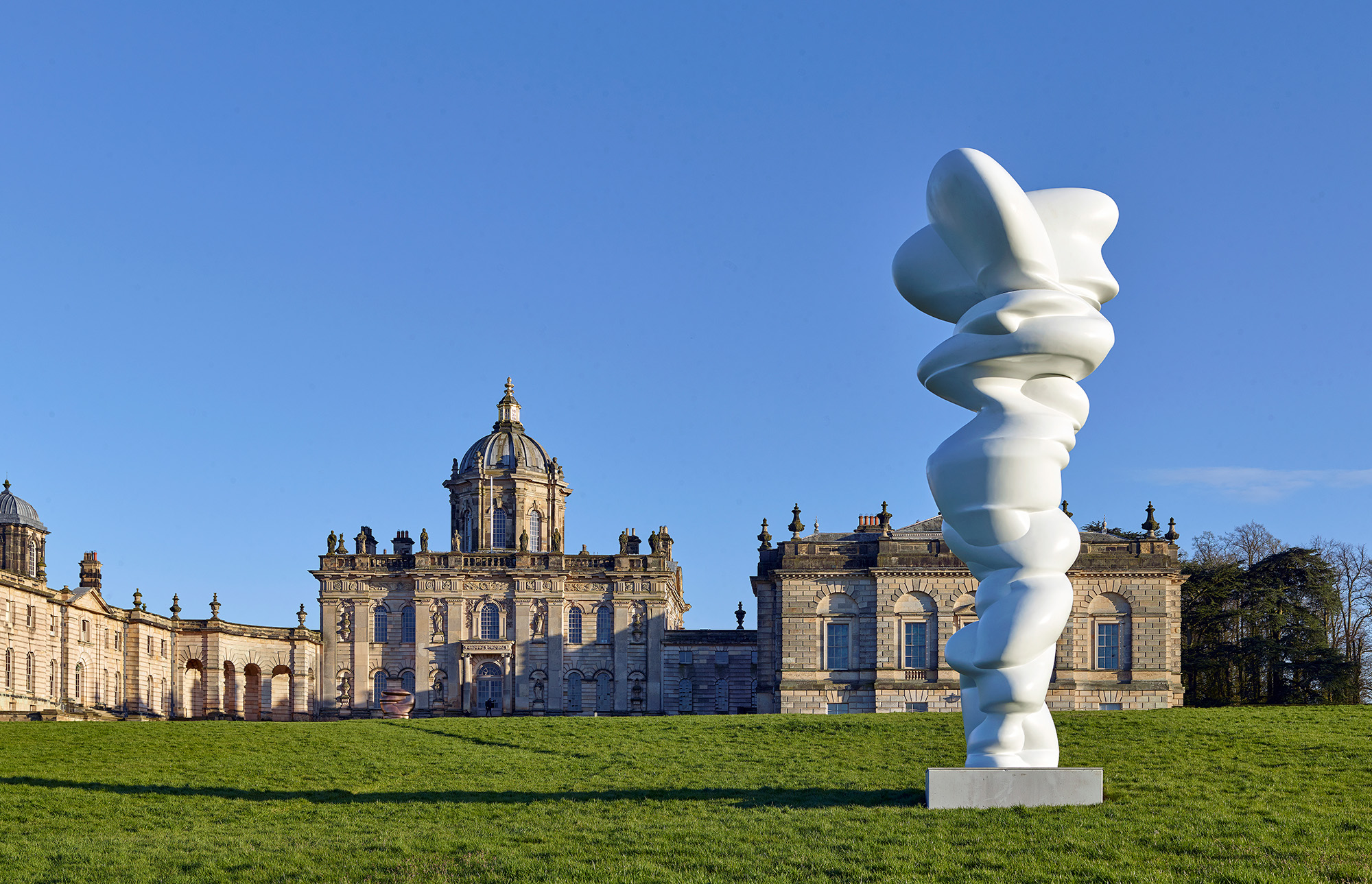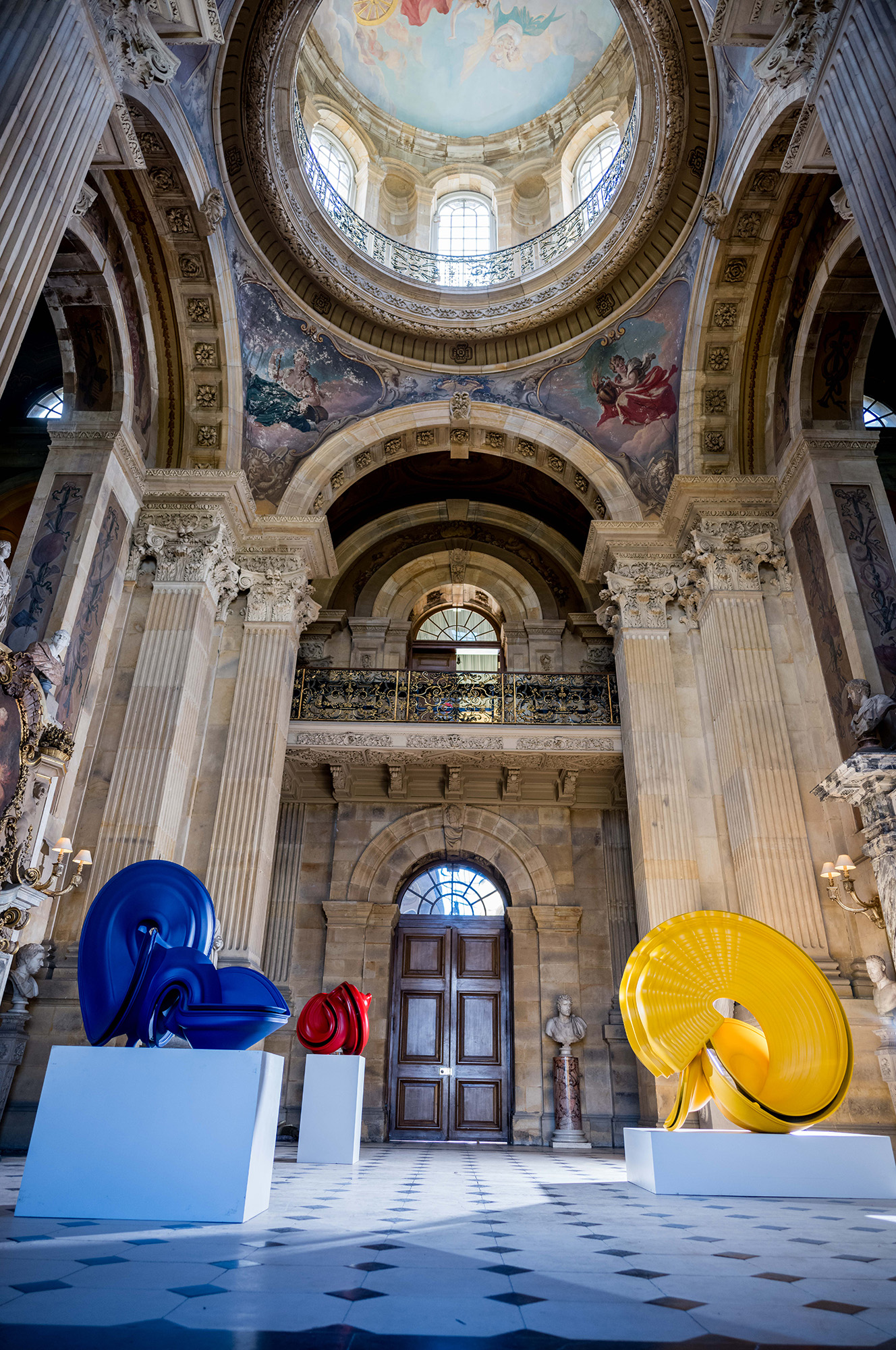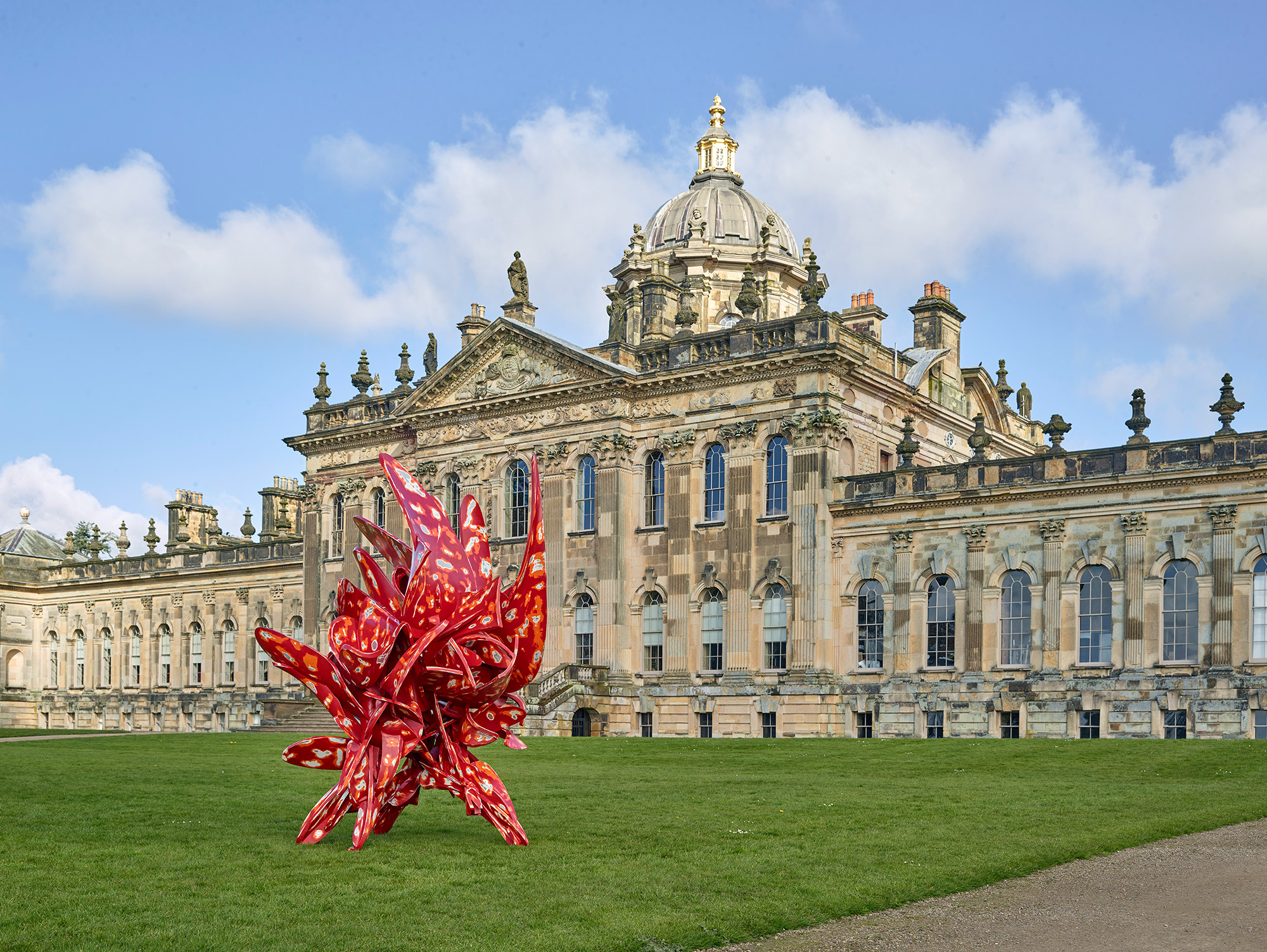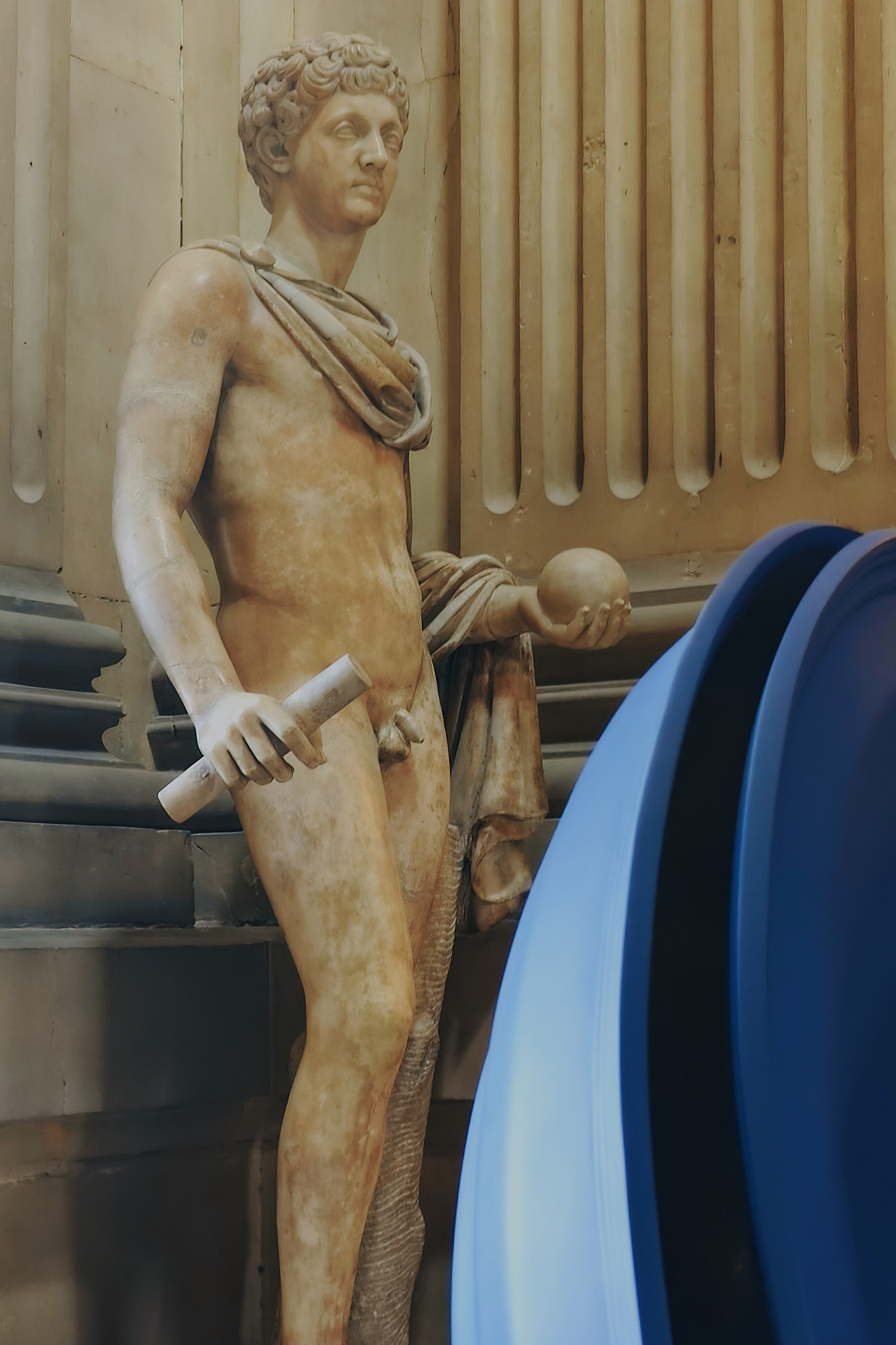Tony Cragg is refracting the English Baroque at Castle Howard
Having been constructed in the early 18th
century, Castle Howard in Yorkshire is an exemplar of the English Baroque style
of architecture. For the first collaboration with a contemporary artist, the
house & its landscape host works by Anglo-German sculptor Tony Cragg in a
display that refracts & riffs of the architecture, decoration &
landscape of the place.
Castle Howard, an exemplar of English Baroque architecture
and home to the same family for 300 years may seem like a quintessential romantic
glimpse into history, preserved in aspic. It is, however, a place that originated at the cutting edge of design and architecture, and having welcomed visitors since the middle of the last century has also been central to the shifting culture of heritage and public access. Now, it brings contemporary art into the fold with its first collaboration with a modern artist, Tony Cragg.
![]()
![]()
![]()
Castle Howard was initially planned by John Vanbrugh, following an invitation from the 3rd Earl of Carlisle to design a grand new Yorkshire country home in 1699. It was quite a first commission for a man who then more of a political radical and dramatist, and an undertaking that needed support – with Vanbrugh bringing in Nicholas Hawksmoor to support him with the project. Over the following four years the design evolved, and by 1725 most of the exterior had been completed. As with all such grand projects, future phases shifted with style and while the latterly-added West Wing took a more restrained Palladian approach, Castle Howard and it’s radical central dome is an iconic moment of English Baroque and has formed a backdrop to film culture including Barry Lyndon, Brideshead Revisited, and Bridgerton.
It is now the latest country house to welcome contemporary art to its rooms and landscape with a wide ranging exhibition by Anglo-German sculptor Tony Cragg, who has carefully placed works in relation to the gardens and richly decorated interiors of the house and temple.
![]()
![]()
![]()
For the visitor, it begins with the arrival on the access road leading to the courtyard entrance to the house. Points of View (2018) , twin spiralling outlines, are placed so they reveal themselves from behind trees as one approaches the house. Positioned so one of the pair aligns behind the other at first, slowly the two forms separate as the point of view evolves, with the highly-reflective stainless steel and eroded-feel of the form shifting how the work is read against the trees.
Two set-pieces follow. Senders (2018), a white fibreglass pile of oversized pebble forms doesn’t read as 6.5 metres tall when set against the mirror-like lakes and the deep estate view, while Masks (2024) is a bronze compression of two forms that plays against the Baroque façade of the house. While none of these works were commissioned or made for site specificity of this place, Cragg has clearly enjoyed working with curators Jon Wood, Greville Worthington, and Chris Ridgway, alongside the wider Castle Howard team, to set the pieces around the site to open up historic and new ways of perceiving the setting.
One such work is Over the Earth (2015), placed on a plinth in the centre of a reservoir used to feed the estate’s fountains, is an example of Cragg’s historic and aesthetic study of place informing placement. The reservoir is high on a hill at the opposite end of the long entrance road, addressing an obelisk designed by Vanbrugh at the road’s other end. The plinth has been empty since its 18th century construction and while it is not known what was originally intended for it, though various artists over Castle Howard’s history proposed statues, Cragg’s winged form is its first work. It sits in the space with an ease that belies the difficulty of its installation, reflected in the waters, playing against the seasonally shifting foliage colours, and subverting the phallic pomp of the obelisk 900 metres away.
![]()
![]()
![]()
The Temple of the Four Winds, designed by Vanbrugh (unmistakably referencing Andrea Palladio’s Villa Rotunda) hosts Eroded Landscape (1999), a precarious stacking of hundreds of sand-blasted glass vessels and objects. The work is ghostly against the exquisite interior stucco by Francesco Vassalli.
A 1940 fire destroyed the suite of state rooms of the east wing, with the dome collapsing into the central hall below. Much was lost – including two Tintorettos – but slowly the family have restored the building, starting with the central dome in the early 1960s. Much of the space is still paired back to its skeleton, however, which now offers a new context to read other Cragg works in which their form is not competing with the intricate Baroque or nature, but set against a more industrial material feel.
Three wooden columns, Points of View (2015) tower up one of these spaces like hysterical Solomonic columns. Formed of tightly layered plywood, the sculptures seem to be growing from the foundations. Inside the wing, a display of Cragg’s drawings on paper and glass works have a space of their own, offering a smaller scale to read the artist’s practice in a more traditional gallery setting. Up close, these works still have the amalgamation of eroded geology with fractured human form so recognisable in his larger pieces, but with these works made in collaboration with glass makers in Murano, there is a fluidity not only in form but present in process.
![]()
![]()
![]()
Under the dome, the repaired central Great Hall is Castle Howard’s most striking interior space, and as such could offer complications for an exhibiting contemporary artist. The richly decorated, Piranesian space of arches, openings, Corinthian columns, statues, and ornate ironwork is a visually overwhelming space, and quite the competition for an artist who may seek to pack the space and compete with large works. Instead, Cragg has left the upwards gaze to the architecture and decoration, and instead worked at ground level with three plinth-based bronze sculptures in sharp red, blue, and yellow. Appearing as extruded, shell-like twists, with glimpses of interior hollows, a spatial distortion, the three works act as a reduction of the key Baroque elements of the surrounding architecture and, as such, both the space and works act as a foil to each other.
All in, there are nineteen sculptures, nine glass works, and fourteen works on paper by Tony Cragg distributed across Castle Howard and its estate, the first collaboration with a contemporary artist the Howard family have undertaken. Cragg has deliberately given very little contextual explanation to the works and their siting, and has rejected the idea of an audio tour of the place, instead wishing that the formal qualities of the works in relation to Vanbrugh and Hawksmoor’s architecture and landscaping speaks for itself. His distortions, refractions, and adaptions of geological and natural forms sit well against the Baroque decoration and natural foliage, not trying to fight against but riff off and play with the existing setting.
![]()
![]()
![]()



figs.i-iii
Castle Howard was initially planned by John Vanbrugh, following an invitation from the 3rd Earl of Carlisle to design a grand new Yorkshire country home in 1699. It was quite a first commission for a man who then more of a political radical and dramatist, and an undertaking that needed support – with Vanbrugh bringing in Nicholas Hawksmoor to support him with the project. Over the following four years the design evolved, and by 1725 most of the exterior had been completed. As with all such grand projects, future phases shifted with style and while the latterly-added West Wing took a more restrained Palladian approach, Castle Howard and it’s radical central dome is an iconic moment of English Baroque and has formed a backdrop to film culture including Barry Lyndon, Brideshead Revisited, and Bridgerton.
It is now the latest country house to welcome contemporary art to its rooms and landscape with a wide ranging exhibition by Anglo-German sculptor Tony Cragg, who has carefully placed works in relation to the gardens and richly decorated interiors of the house and temple.



figs.iv-vi
For the visitor, it begins with the arrival on the access road leading to the courtyard entrance to the house. Points of View (2018) , twin spiralling outlines, are placed so they reveal themselves from behind trees as one approaches the house. Positioned so one of the pair aligns behind the other at first, slowly the two forms separate as the point of view evolves, with the highly-reflective stainless steel and eroded-feel of the form shifting how the work is read against the trees.
Two set-pieces follow. Senders (2018), a white fibreglass pile of oversized pebble forms doesn’t read as 6.5 metres tall when set against the mirror-like lakes and the deep estate view, while Masks (2024) is a bronze compression of two forms that plays against the Baroque façade of the house. While none of these works were commissioned or made for site specificity of this place, Cragg has clearly enjoyed working with curators Jon Wood, Greville Worthington, and Chris Ridgway, alongside the wider Castle Howard team, to set the pieces around the site to open up historic and new ways of perceiving the setting.
One such work is Over the Earth (2015), placed on a plinth in the centre of a reservoir used to feed the estate’s fountains, is an example of Cragg’s historic and aesthetic study of place informing placement. The reservoir is high on a hill at the opposite end of the long entrance road, addressing an obelisk designed by Vanbrugh at the road’s other end. The plinth has been empty since its 18th century construction and while it is not known what was originally intended for it, though various artists over Castle Howard’s history proposed statues, Cragg’s winged form is its first work. It sits in the space with an ease that belies the difficulty of its installation, reflected in the waters, playing against the seasonally shifting foliage colours, and subverting the phallic pomp of the obelisk 900 metres away.



figs.vii-ix
The Temple of the Four Winds, designed by Vanbrugh (unmistakably referencing Andrea Palladio’s Villa Rotunda) hosts Eroded Landscape (1999), a precarious stacking of hundreds of sand-blasted glass vessels and objects. The work is ghostly against the exquisite interior stucco by Francesco Vassalli.
A 1940 fire destroyed the suite of state rooms of the east wing, with the dome collapsing into the central hall below. Much was lost – including two Tintorettos – but slowly the family have restored the building, starting with the central dome in the early 1960s. Much of the space is still paired back to its skeleton, however, which now offers a new context to read other Cragg works in which their form is not competing with the intricate Baroque or nature, but set against a more industrial material feel.
Three wooden columns, Points of View (2015) tower up one of these spaces like hysterical Solomonic columns. Formed of tightly layered plywood, the sculptures seem to be growing from the foundations. Inside the wing, a display of Cragg’s drawings on paper and glass works have a space of their own, offering a smaller scale to read the artist’s practice in a more traditional gallery setting. Up close, these works still have the amalgamation of eroded geology with fractured human form so recognisable in his larger pieces, but with these works made in collaboration with glass makers in Murano, there is a fluidity not only in form but present in process.



figs.x-xii
Under the dome, the repaired central Great Hall is Castle Howard’s most striking interior space, and as such could offer complications for an exhibiting contemporary artist. The richly decorated, Piranesian space of arches, openings, Corinthian columns, statues, and ornate ironwork is a visually overwhelming space, and quite the competition for an artist who may seek to pack the space and compete with large works. Instead, Cragg has left the upwards gaze to the architecture and decoration, and instead worked at ground level with three plinth-based bronze sculptures in sharp red, blue, and yellow. Appearing as extruded, shell-like twists, with glimpses of interior hollows, a spatial distortion, the three works act as a reduction of the key Baroque elements of the surrounding architecture and, as such, both the space and works act as a foil to each other.
All in, there are nineteen sculptures, nine glass works, and fourteen works on paper by Tony Cragg distributed across Castle Howard and its estate, the first collaboration with a contemporary artist the Howard family have undertaken. Cragg has deliberately given very little contextual explanation to the works and their siting, and has rejected the idea of an audio tour of the place, instead wishing that the formal qualities of the works in relation to Vanbrugh and Hawksmoor’s architecture and landscaping speaks for itself. His distortions, refractions, and adaptions of geological and natural forms sit well against the Baroque decoration and natural foliage, not trying to fight against but riff off and play with the existing setting.



figs.xiii-xv
Tony Cragg has been working and exhibiting since 1969. He was awarded the Turner Prize in 1988, the prestigious Praemium Imperiale Award, Tokyo in 2007 and the Lifetime Achievement in Contemporary Sculpture Award in 2017. He has exhibited extensively in museums worldwide: Tate Gallery, London (1988), Stedelijk Van Abbemuseum, Eindhoven and Kunstsammlung Nordrhein-Westfalen, Duesseldorf (1989), Scottish National Gallery of Modern Art, Edinburgh and Musée du Louvre, Paris (2011), Lehmbruck Museum, Duisburg (2013), Von der Heydt-Museum, Wuppertal and Hermitage Museum, St Petersburg (2016) and Boboli Gardens, Florence (2019).
He has lived in Wuppertal, Germany since 1977.
www.tony-cragg.com
Castle Howard is a stately home in North Yorkshire, England,
15 miles north of York. Set in the Howardian Hills National Landscape, Castle
Howard is a private residence and has been home to the Howard family for more
than 300 years. Castle Howard was commissioned by the 3rd Earl of Carlisle in
1699 and took over 100 years to complete. Successive generations have welcomed
visitors to the House and it was first opened to the public by George Howard in
1952. Visitors can expect dramatic interiors and world-renowned art collections
inside the House. The Gardens offer extensive woodland walks, temples, lakes
and fountains with an adventure playground for the younger visitors to burn off
steam. Castle Howard welcomes more than 270,000 visitors per year.
www.castlehoward.co.uk
www.castlehoward.co.uk


